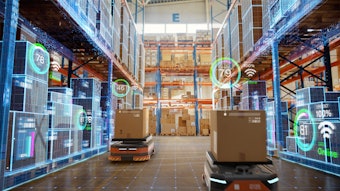
Freight transportation has seen its fair share of AI-powered promises over the years. However, two shifts in the market are reshaping how freight brokers and procurement pros use artificial intelligence and automation to operate and deliver value to their customers.
The first is technological.
AI and automation have moved from simple rules-based programming for route planning and schedules to sophisticated machine-learning models trained on enormous datasets. These models can learn patterns from the data and make predictions or decisions without being explicitly programmed.
Today’s AI can automatically match loads to carriers based on rates, location, capabilities, and availability—and negotiate and book them. Executed well, a dynamic, fully digital, AI-based approach to pricing and procurement has obvious advantages over routing guides built on months-old RFPs or posting freight to an open load board.
The second change involves mindset.
Brokers and shippers have evolved to recognize AI as less of a cost-cutting tool and more for its potential to help human beings focus on things algorithms can’t do as well, like judgment, context, and nuance. AI helps, but these human qualities, experience, and relationships are still the keys to putting the right load on the right truck for the right price.
The good news for freight executives is that the benefits of AI and automation are available to virtually any logistics operation, not just giant 3PLs or digital brokers with technology-first platforms.
AI in a freight context
Those old “AI-powered” claims created a lot of confusion about what the technology really does. So let’s define some terms.
AI is a broad field that includes any system designed to mimic human intelligence. Machine learning refers to algorithms that allow computers to learn from data and improve over time.
AI and machine learning go hand in hand. If AI is an engine, data is the fuel.
For AI to recognize patterns in truckload transportation, it needs high-quality information about carriers, like where they’re going, what they’re doing, how many trucks they have, and what kinds of loads they carry. The data becomes more valuable—and the AI more effective—when the carrier provides actual locations from the truck’s electronic logging device or an app on the driver’s mobile phone.
Where does data come from?
When you’re evaluating AI-based systems, data is a key differentiator. Where does it come from? How reliable is the source? Is it cleaned and verified?
For example, one of the richest data sources is the freight transaction. Every bit of information on an invoice or bill of lading—pricing, origin/destination, pickup dates, fuel surcharges—can be extracted and validated as part of a machine-learning model. With algorithms analyzing millions of transactions across tens of thousands of lanes, brokers and shippers can automatically compare their prices to the prevailing rates for truckload services on any given lane at any time of year, accounting for short-term market effects, seasonal impacts, and long-term price trends.
The most advanced platforms don’t just react to market conditions; they anticipate them. Based on transaction data and other factors, machine learning models can forecast rate fluctuations days or weeks in advance, helping shippers and brokers negotiate terms that make sense for their operation at that moment.
This AI application is incredibly useful, but its reliability and value depend on high-quality data.
Practical applications
When you put it all together—the algorithms, data, and ability to help people use their judgment and relationships—one of the best examples of AI and automation delivering bottom-line benefits involves double brokering and identity theft. Here’s how an AI-based system can create multiple layers of protection against fraud:
- Carrier verification and authentication: AI can automatically verify carrier credentials and authority against trusted databases, flagging suspicious carriers or those with a history of double brokering. It builds carrier profiles based on past performance data, helping shippers and brokers identify trusted carriers with proven track records. AI can analyze relationships between carriers to identify potential shell companies or suspicious connections that might facilitate double brokering.
- Behavioral pattern recognition: AI algorithms analyze carrier booking patterns and can detect suspicious behaviors that might indicate double brokering. These include a carrier repeatedly booking loads in regions where it doesn't typically operate, connection attempts from high-risk offshore data centers, and device scramblers and VOIP phones that mask carrier identities.
- Digital load tracking: Real-time visibility solutions ensure that the truck and driver assigned to a load are the ones moving it, making it harder for freight to be passed to unauthorized carriers. This includes “railing” loads—placing freight on intermodal rail when the contract is for over-the-road transport.
- Document verification: AI-powered systems can authenticate paperwork and identify inconsistencies or forgeries in documentation that might suggest double brokering. They can create a secure digital chain of custody for load assignments, making it clear who has legitimate authority to move a shipment.
Collectively, these tools can help shippers and brokers maintain control of their freight and protect their relationships with legitimate carriers. Real-time visibility also lets shippers be proactive and prevent disruptions, such as rescheduling appointments when loads are behind schedule.
Looking at what’s next, the most effective formula continues to be a combination of AI and human experience. Let the technology handle pattern recognition, data processing, mundane tasks, and routine decisions so people can focus on what they love about freight in the first place—solving hard problems, helping customers, and managing relationships. Ultimately, that’s the real promise of AI in freight.


![Pros To Know 2025 [color]](https://img.sdcexec.com/files/base/acbm/scn/image/2025/01/Pros_To_Know_2025__color_.67856cb23da64.png?auto=format%2Ccompress&fit=crop&h=191&q=70&w=340)






















